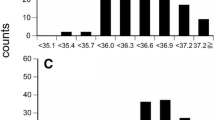Abstract
Introduction and hypothesis
The International Continence Society (ICS) adopted 1.3 g as the normative value for the 24-h pad test. We hypothesized that this cutoff value may not be valid for women who live in countries with high temperatures.
Methods
We documented the 24-h pad test values of continent women in Brazil and investigated the factors that can influence in vaginal humidity.
Results
The sample consisted of 257 participants. The temperatures ranged from 19°C to 27.8°C. The median increase in the weight of the pad was 1.9 g (1.4–3.0 g, 95th percentile 4.4 g). Pad test results differed significantly between pre- and postmenopausal women (p = 0.026). There was a significant difference in the pad weights of women who use hormone therapy (p = 0.003).
Conclusions
The value of the 24-h pad test established by the ICS was not valid for the investigated sample. Environmental conditions, menopausal status, and use of hormone therapy can interfere with the values of the pad test.

Similar content being viewed by others
References
Haylen BT, Ridder D, Freeman RM et al (2010) An International Urogynecological Association (IUGA)/International Continence Society (ICS) joint report on the terminology for female pelvic floor dysfunction. Neurourol Urodyn 29:4–20
Abrams P, Cardozo L, Fall M, Griffiths D, Rosier P, Ulmsten U (2002) The standardisation of terminology of lower urinary tract function: report from the standardisation sub-committee of the International Continence Society. Neurourol Urodyn 21(2):167–78
Matharu GS, Assassa RP, Williams KS et al (2004) Objective assessment of urinary incontinence in women: comparison of the one-hour and 24-hour pad test. Eur Urol 45:208–12
Walsh JB, Milis GL (1981) Measurement of urine loss in elderly incontinent patients. A single and accurate method. Lancet 1:1130–31
Victor A (1990) Pad weighing test—a simple method to quantitate urinary incontinence. Ann Med 22:443–7
Sutherst J, Brown M, Shawer M (1981) Assessing the severity of urinary incontinence in women by weighing perineal pads. Lancet 1:1128–30
Karantanis E, O’Sullivan R, Moore KH (2003) The 24-hour pad test in continent women and men: normal values and cyclical alterations. BJOG 110:567–71
Victor A, Larsson G, Asbrink AS (1987) A simple patient administered test for objective quantitation of the symptom of urinary incontinence. Scand J Urol Nephrol 21(4):277–9
Jorgensen L, Lose G, Thunedborg P (1987) Diagnosis of mild stress incontinence in females: 24-hour pad weighing test versus the one-hour test. Neurourol Urodyn 6:165–6
Tubaro A, Artibani A, Bartram C, DeLancey J, Khullar V, Vierhout M (2009) Imaging and other investigations. In: Abrams P, Cardozo L, Khoury S, Wein A (eds) Incontinence. Health, Paris, pp 541–630
Ryhammer AM, Laurberg S, Djurhuus JC, Hermann AP (1998) No relationship between subjective assessment of urinary incontinence and pad test weight gain in a random population sample of menopausal women. J Urol 159(3):800–3
Karantanis E, Miller T, Moore K (2004) The 24-hour pad test: pad composition affects accuracy. Neurourol Urodyn 23(5/6):570–571, Abstract 122
Huggins GR, Preti G (1981) Vaginal odors and secretions. Clin Obstet Gynecol 24:355–77
Overstreet JW, Katz DF, Yudin AI (1991) Cervical mucus and sperm transport in reproduction. Semin Perinatol 15(2):149–55
Kingsberg SA (2002) Reproductive senescence and depression revisited (again). Menopause 9(6):389–91
Acknowledgments
We would like to gratefully acknowledge the support from Pró-Reitoria de Pesquisa of Universidade Federal de Minas Gerais, Brazil.
Conflicts of interest
None.
Author information
Authors and Affiliations
Corresponding author
Rights and permissions
About this article
Cite this article
Figueiredo, E.M., Gontijo, R., Vaz, C.T. et al. The results of a 24-h pad test in Brazilian women. Int Urogynecol J 23, 785–789 (2012). https://doi.org/10.1007/s00192-011-1645-3
Received:
Accepted:
Published:
Issue Date:
DOI: https://doi.org/10.1007/s00192-011-1645-3




